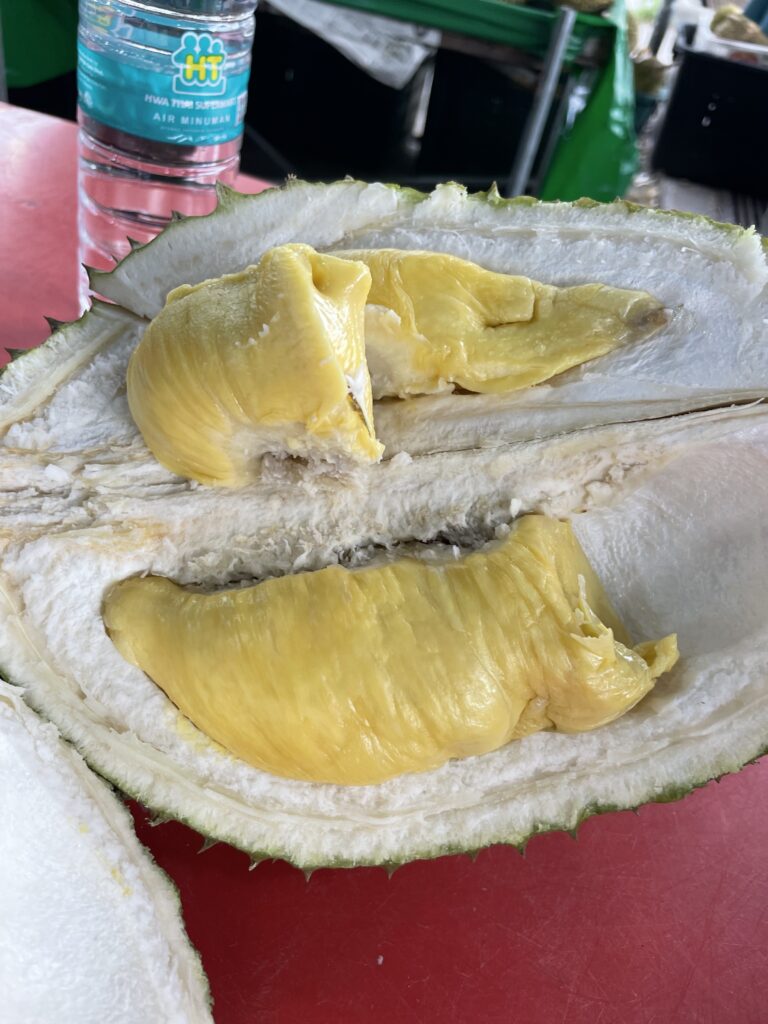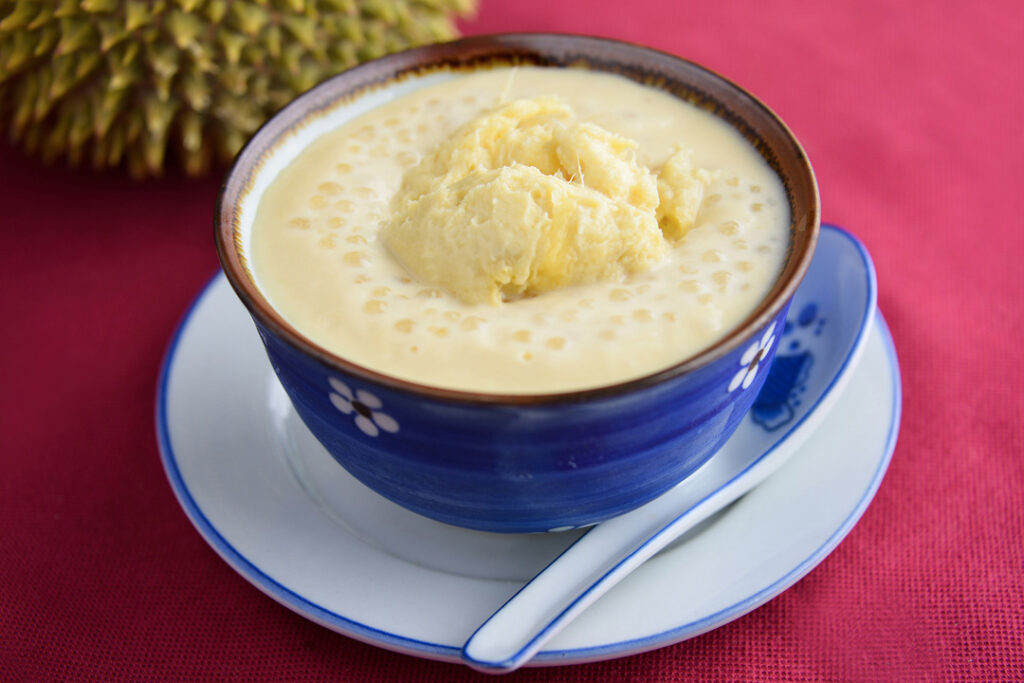Introduction
Durian, the enigmatic and notorious “King of Fruits,” is a tropical delight that has captivated taste buds and sparked intense debates among food enthusiasts worldwide. Known for its pungent aroma and distinctive taste, this spiky fruit has become an icon of Southeast Asian cuisine.
In this write-up, let’s discover together the unique attributes of durian, explore its health benefits, discuss the best ways to enjoy it, and uncover the fascinating cultural significance behind this beloved fruit.
What is Durian?
Durian (Durio zibethinus) is a large, oval-shaped fruit with a spiky green or brown husk. Native to Southeast Asia, particularly Malaysia, Indonesia, and Thailand, durian has earned its regal title due to its formidable size and striking appearance. Inside the thorny exterior, the fruit’s creamy, custard-like flesh awaits, surrounded by large seeds.
The Peculiar Aroma
Bold, pungent, and divisive – these words perfectly describe the aroma of durian. While some people adore its unique scent, often likened to a blend of sweet custard and sulfurous onions, others find it repulsive, even comparing it to rotting garbage. This intense aroma has led to durian being banned in certain public places like hotels and public transportation in Southeast Asian countries. Nevertheless, enthusiasts and adventurers alike are drawn to the fruit, eager to experience its distinctive flavor.
The Unforgettable Flavor
Once you get past the overpowering aroma, you’ll discover the irresistible taste that has won the hearts of many. The flesh of the durian is rich, creamy, and bursting with complex flavors. It offers a combination of sweetness, slight bitterness, and subtle nuttiness. The texture is soft and smooth, making it feel like a luscious custard melting in your mouth. These attributes have led to durian being often dubbed as the “custard of fruits” or the “creme brulee of fruits.”
Nutritional Value and Health Benefits
Beyond its delectable taste, durian packs a punch in terms of nutritional value. It is abundant in essential vitamins, minerals, and fiber, making it a wholesome addition to any diet. Here are some of the key nutrients found in durian:
- Vitamin C: Durian is a great source of vitamin C, a potent antioxidant that supports the immune system and promotes healthy skin.
- Potassium: This mineral is essential for maintaining proper heart function and regulating blood pressure.
- Fiber: Durian is rich in dietary fiber, which aids digestion, helps maintain a healthy weight, and keeps cholesterol levels in check.
- B vitamins: Durian contains various B vitamins, including B6, thiamin, and folate, which play crucial roles in metabolism and overall health.
- Iron: The fruit provides a good dose of iron, important for red blood cell production and preventing anemia.
Durians are also rich in polyphenols such as flavonoids and carotenoids – compounds which have antioxidant properties that promote heart and skin health, lowering blood pressure, reduce heart diseases and strenghten the immune system.
While durian offers an array of health benefits, its high calorie and carbohydrate content means that it should be consumed in moderation, especially by individuals watching their weight or blood sugar levels.
How to Enjoy Durian?
Savoring durian is a cherished experience among its enthusiasts. While many locals in Southeast Asia enjoy it fresh and raw, there are various creative ways to incorporate durian into delightful dishes and desserts. Here are some popular methods of consuming durian:
1. Fresh and Raw
The traditional way to enjoy durian is by simply eating it fresh and raw. To do so, use a sharp knife to crack open the husk, revealing the creamy yellow flesh inside. Be cautious of the spikes as they can be sharp. Take a bite and let the flavors dance on your taste buds.
2. Durian Ice Cream
For a cooler and creamier treat, try durian ice cream. Its velvety texture and intense flavor will leave you craving more. Many ice cream parlors in Southeast Asia offer durian-flavored options, and it has become increasingly popular worldwide.
3. Durian Pancakes
Durian pancakes are a delightful fusion of Western and Asian flavors. The soft pancakes envelop the luscious durian filling, creating a heavenly combination of textures and tastes.
4. Durian Smoothies
Blend the durian flesh with milk, ice, and a touch of sweetness for a refreshing and nutritious smoothie. It’s a fantastic way to enjoy durian’s flavor while staying cool on a hot day.
5. Durian Pastries and Cakes
Durian’s unique taste can be beautifully incorporated into pastries and cakes. From durian tarts to durian mille crepe cakes, these treats are sure to tantalize your taste buds.
6. Durian Desserts
For the dessert lover, the unique and exotic flavors of durian lend themselves perfectly to various dessert creations. Each bite of a durian dessert offers a glimpse into the tropical paradise that this “King of Fruits” calls home. Head to Ah Chew Desserts your nearest tropical dessert haven to savor the wonderful array of durian delicacies waiting to tantalize your taste buds.
Types of Durian
The King of Fruits offers a diverse range of flavors and textures across its various types to satisfy your taste buds. Each type of durian presents its own nuances and characteristics, ensuring a memorable and exciting gustatory adventure for fruit lovers worldwide. Let’s have a look on the different types of durian here:
- Musang King Durians or mostly known as Mao Shan Wang in Mandarin (MSW) is arguably the most sought-after and highly prized variety of durian. Grown predominantly in Malaysia, it features a luscious golden flesh and a strong, sweet flavor with hints of bitterness and relatively small seeds. The rich creamy and custard-like texture is what makes it stand out, making it a favorite among durian enthusiasts.
- XO Durians is one of the creamiest and most buttery varieties available. Its name derives from the process of aging the durian flesh, similar to the method used for XO Cognac. As the name suggest, this durian has a slightly alcoholic aftertaste. This aging intensifies its flavors, giving it a smooth, velvety texture and a well-balanced taste that lingers on the palate. The seeds varies from small to larger sizes and have a softer flesh with higher water content, hence more runny.
- D24 Durians is another popular variety, cherished for its alluring aroma and delightful taste. Originating from Malaysia and Thailand, it boasts a pale yellow flesh that is slightly drier than Musang King but no less flavorful. Its creamy and slight bitter taste with a buttery aftertaste makes it a delightful choice for durian aficionados. The seeds are rounder and pale yellow in colour.
- Black Thorn or Black Pear, has a distinctive dark-colored thorn-covered husk, setting it apart from other varieties. Cultivated mainly in Penang, Malaysia, this durian type is known for its smooth, creamy, and intensely flavored flesh. Its taste is a harmonious blend of sweet and bitter notes, making it an unforgettable gustatory experience. The small seeds are pale greyish in colour.
- Red Prawn or “Ang Heh” in Hokkien, is a lesser-known gem among durian varieties. Hailing from Penang, Malaysia, this durian type has a reddish hue and a soft, succulent flesh. Its milky aftertaste is a blend of sweetness and mild bitterness, creating a delightful contrast that appeals to those who prefer a less overpowering durian flavor. The seeds are larger and orange/red in colour.

Cultural Significance of Durian
Beyond its culinary allure, durian holds immense cultural significance in Southeast Asia. It is often considered a symbol of hospitality and generosity, with locals offering the fruit as a gesture of welcome to guests. Additionally, durian features prominently in various traditional festivals and rituals, signifying abundance and prosperity.
In some Southeast Asian countries, durian is also believed to possess aphrodisiac properties, making it a fruit of romance and sensuality. However, this belief is not scientifically proven and should be taken with a grain of salt.
Conclusion
In conclusion, durian is undoubtedly a fruit that evokes strong emotions and opinions. Its distinct aroma and unforgettable taste have made it a subject of fascination and debate worldwide. With its impressive nutritional profile and unique culinary potential, durian continues to be celebrated by food enthusiasts and embraced by those eager to experience something truly special.
So, the next time you come across this spiky, custard-like wonder, don’t shy away. Embrace the adventure, savor the flavor, and discover why durian rightfully earns its title as the “King of Fruits.”
FAQs (Frequently Asked Questions)
1. Is it true that durian is banned in some public places?
Yes, that’s correct. Due to its strong smell, durian is prohibited in certain hotels and public transportation systems in Southeast Asian countries.
2. Can I bring durian on a flight?
Bringing durian on a flight is generally discouraged as its odor can be overpowering and disruptive to other passengers. Airlines have specific rules regarding carrying durian, so it’s best to check with the airline beforehand.
3. Are there different varieties of durian?
Yes, there are numerous durian varieties, each with its unique flavor and texture characteristics. Some popular varieties include Musang King, D24, and XO. Each variety has its dedicated fan base and is often subject to taste tests and competitions to determine the best one.
4. Are durians suitable for individuals with diabetes?
Yes, durians can be included in the diet of individuals with diabetes. The flavonoids in durians have shown promise in helping manage blood sugar levels and improving insulin sensitivity. Nonetheless, people with diabetes should also be mindful that larger seeds contain higher amounts of carbohydrate thus can increase blood sugar levels. Enjoying durian in moderation is recommended.
